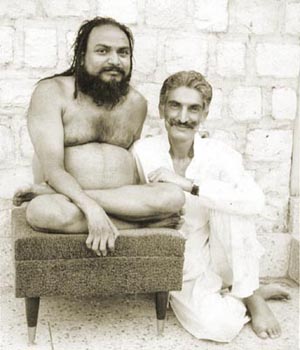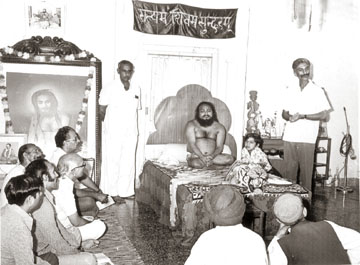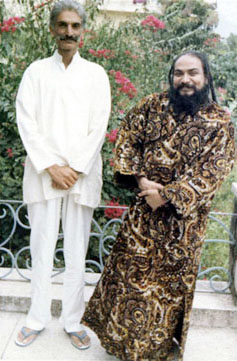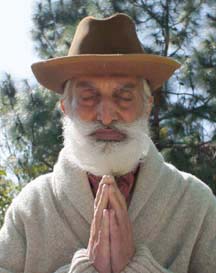SOUL CONNECTIONS HOME | PREVIOUS PAGE | NEXT PAGE

General Hanut Singh with Shivabalayogi.
Photo taken at the Dehradun ashram.

General Hanut is the author of the first biography of Shivabalayogi available in
the West,
Shri Shri Shri Shivabalayogi Maharaj, Life & Spiritual Ministration,
published in 1981.
General Hanut Singh
The story of how he met Shivabalayogi, in the General's own words.
I had been looking for a siddha purusha, a realized soul, since I was a child. I wanted to a guru whose teaching I could follow. I used to read from books, follow a certain path, and I would read something else. I used to be attracted by that and I followed different paths. I also realized that unless I was stable in the spiritual practice that I was doing, I wouldn’t attain anything very much.
So I used to travel to all the places where saints and mahatmas were known to reside. I went to Rishikesh. I went to Badrinath. I went to Gangotri and Kashi. I met all the sadhus and saints there who were reputed to be great saints. They were undoubtedly great saints in their own right, but none of them attracted me internally. I was not attracted towards them. I revered them, but I could not believe that I could follow them as guru.
I first heard of Shri Shivabalayogi Maharaj in the summer of 1968. One day I got a telephone call from a close and dear friend of mine, Major (later General) Ajai Singh. He was then posted at Delhi. Major Ajai Singh, sent me word that a mahatma had come to Delhi who was performing many miraculous cures. He asked me to come to Delhi and have his darshan. I was not impressed. I had heard of many miracle men and these things did not attract me. By now I was quite disillusioned. So I said, “I have seen any number of these great saints. I’m not interested.” I did not go.
Then when I came to Delhi, again Ajai spoke to me about him. Ajai’s brother-in-law also mentioned Swamiji. He said that Swamiji was in Dehradun and I should go see him and have his darshan. I thought to myself, “Yes, if he is a great saint, it would be worthwhile having darshan.” In any case I was planning to come to Dehradun.
During this period I was afflicted by chronic amoebic dysentery which had been with me for almost ten years. Hari Singhji of Jalalpur suggested that I visit a Swami who was at Dehradun at that time and who was effecting many miracle cures. I was so distraught because of my debilitating disease that I was prepared to try anything.
In June of 1968, I went to Dehradun on a short holiday. When I arrived, I got the address where Swamiji was staying. It was a Sunday and I was informed that Swamiji gave darshan from 5 p.m. to 8 p.m. We reached the house at about 5:30 p.m. When the door opened for darshan I went in. As I entered the room where Shri Swamiji was giving darshan, Swamiji was sitting on the bed in a very in drawn mood. In those days, Swamiji used to be in a meditative mood most of the time. I observed a yogi wearing only a kaupina, with long matted hair and seated on a tiger skin. He had a withdrawn meditative look on his face and there was an atmosphere of deep calm and supreme peace pervading the room.
The moment I saw him, something within me got pulled towards him. Something within me was greatly attracted by him. Immediately the thought struck me, “Your long quest for your Guru has ended. There in front of you sits your Guru!” So I sat down and kept gazing at Swamiji. I was at once captivated by the yogi and could not take my eyes off him. I barely noticed the others in the room. I had eyes only for this mahatma. I was gazing at him critically. I wanted to make up my own mind whether he was the person I was looking for. The more I looked at him, the more I saw him, the more I felt yes. He was the person that I had been looking for so long.
Then when the bhajan and kirtan (spiritual song) started, Swamiji went into dhyana (meditation) and he went into deep samadhi. To me it appeared like samadhi because it was a very deep state of dhyana which he had gone into and he appeared to be totally unconscious of the outer world. That further convinced me that my initial intuition had been correct and Swamiji was one person I would like to follow, if he accepted me.
That evening, for the first time, I heard kirtan done in Shri Swamiji’s presence and saw the wonderful leelaof devotees going into bhava. I was enthralled not only with what I saw, but particularly with what I personally experienced during that kirtan.
In all the books I had been reading, it was mentioned that “When the time is ripe, your Guru will come of his own accord,” and “You don’t have to search for a Guru; he will search you out and draw you to him,” and so on. Whenever I heard of a great mahatma, I would go and visit him in the hope that perhaps he may be the Guru I was looking for, but none attracted me to the extent that I would want to be their disciple. The Guru-disciple relationship is very deep and very sacred and to those who understand it, it not easily entered into. Thus my sense of gratification and fulfillment at finding my own longed and searched for a Guru.

General Hanut (right) and Adinarayan (left) standing beside Shivabalayogi who is sitting on his asana at the Dehradun ashram.
I had been given a letter of introduction to Rani Saheba of Patna [Srimati Kailas Kumari Devi, the Maharini of Patna, whom Swamiji called Mataji]. The letter was from Hari Babu, Ajai’s brother-in-law whose son was married to Maharani Patna’s daughter. So when the bhajan and kirtan were over, I handed over that letter to the Maharani Sahib, that I am so-and-so. I introduced myself. I said this is the problem I have and I wonder whether the Swamiji could help me.
Maharini Saheba passed on the letter I had brought to Shri Veerabhadraiah who was attending Shri Swamiji at that time. Shri Veerabhadraiah conveyed the contents of the letter to Swamiji who asked whether I wanted the vibhuti (blessed ash) now or would I wait. Of course, I agreed to wait.
Later Swamiji called me and said, “If I give you some vibhuti, will you take it?”
“I will gladly take it.”
He gave me some vibhuti and asked me to take it with water three times a day after duly worshipping it. I carried out his injunctions as directed and when I took the vibhuti, I began to feel as though my entire system was being purged and flushed. This carried on for two to three days and, to all outward appearances, the disease instead of abating had taken a turn for the worse. But disregarding all this, I continued taking the vibhuti and did not touch any of the numerous medicines which I had been taking habitually almost daily. By about the third day, there were signs of improvement and I felt a sense of well being that I had not experienced for years. Thereafter, there was steady improvement until I was fully cured of this foul disease, something that doctors had been unable to do for ten long years in spite of administering the best available allopathic medicines.
I think a day or two after that first day, after the conviction had grown in me, I inquired whether I could take initiation from Him. To my surprise, Swamiji said yes. I should come on Thursday. So I went on Thursday very excited because I felt that at last I was on the threshold of starting off on a spiritual sadhana (practice) I had been wanting to indulge in all my life, to that point of time.
There was nobody else for the initiation that day. I was the only candidate. I was made to sit in front of Swamiji and Mr. Adinarayana. Was it Mr. Adinarayana or Mr. Veerabhadraiah? One of them. I’m not sure now. He came to me, told me to close my eyes, and pressed me between the eyebrows. Possibly he applied vibhuti there. I’m not sure. He told me to concentrate on that point.
So I sat in dhyana in front of Swamiji for about an hour. Swamiji was there all the time. A deep sense of peace flooded me during that period. When it was over, I was asked to open my eyes and I was given some instructions which I did not follow in their entirety. But I did understand this much, that I was to concentrate on the point between the eyebrows.
Then Swamiji told me personally that, “You should make sure when you are doing dhyana, your vision should be steady. Your eyes, eyeballs should not flicker. That will automatically bring steadiness in your meditation.” These two points I grasped, which I suppose were adequate for a beginner.

General Hanut with Shivabalayogi
at the Dehradun ashram.
Then during the kirtan that followed, Anang [Singh Deo] went into bhava and he repeatedly came and with his thumb kept pressing me or putting a mark on my bhrikuti, the point between the eyebrows. And repeatedly he would tap me on the back. Then one of the ladies who was in bhava came and she ran her hands on my stomach. I was new to all this, so I thought possibly these are means by which Swamiji is conveying His blessings. I felt nothing in particular except that I had better dhyana during the kirtan that followed than during the initiation period itself.
But I was so attracted by that dhyana that I had done at that time, that I started coming regularly there and sitting in the presence of Swamiji and doing meditation. At that time, the routine used to be that the first one hour was devoted to dhyana. Then if there were any aspirants for initiation, they used to be given initiation on Thursdays and Sundays. For the rest, during that one hour period, whoever wanted to could come and sit in dhyana and Swamiji used to be sitting there personally Himself. By the spiritual power that used to emanate from Swamiji during those days, we used to go into a state of deep dhyana without any effort on our part. We used to be surprised when the hour ended and Mr. Veerabhadraiah started the kirtan. We used to feel that, “Oh why are they starting the kirtan. We should continue a little longer.”
But, again, after the initial disturbance, the kirtan used to create a very pleasant sort of an atmosphere which induced one to go into another session of dhyana. We used to sit in dhyana during the kirtan also. And at times it used to be so strong, that the arthi used to follow and people used to disperse but there was no inclination of terminating the dhyana and wanting to get up and go. I was conscious of the fact that people are dispersing and that it was time for Swamiji’s evening meal. Food had been brought in and I should leave, because Swamiji would not begin to eat in the presence of His devotees. I was completely new to them. But I couldn’t open my eyes.
I couldn’t open my eyes. Consciously I wanted to get up but I couldn’t open my eyes and I didn’t want to force myself to leave. So eventually somebody would come with a little vibhuti and press that vibhuti at the bhrikuti and keep tapping me for some time. And then my eyes would open. When I looked at Swamiji after that, I would find him smiling at me. I used to smile a little self-consciously because I had kept everybody waiting, then quickly go to pranam (bow) to Swamiji and leave.
I had only a fortnight leave at that time and that’s how I spent that wonderful period of leave.
That was not my first experience of meditation, but until then I really did not know what was the correct technique of meditation. I used to simply sit with my eyes closed and I would do japa or try to bring a picture of my ishtadeva (form of God one prefers to worship) in front of my eyes and concentrate on that. Somewhere else I had read that you should keep your mantra in front of your mind so I tried to keep that. It kept varying according to what I read or what I heard people saying. There was no specific technique I was following. Actually, I was not progressing in any direction.
 Of course, more important than all that is that in dhyana, it
is not the mantra you follow or the technique you are taught. It is the dhyana diksha (initiation into meditation)
that the guru gives you. This is the crucial factor. Without the shakti (spiritual power) you cannot do
dhyana. Your mind cannot be brought under control. Your own effort, the individual human effort, is
not adequate to bring
the mind under control. It is the
guru’s shakti that enables you. This
shakti Swamiji provided. With little
effort the mind used to become under control and it used to be flooded with
peace. That was the motivating
factor to continue the dhyana.
Of course, more important than all that is that in dhyana, it
is not the mantra you follow or the technique you are taught. It is the dhyana diksha (initiation into meditation)
that the guru gives you. This is the crucial factor. Without the shakti (spiritual power) you cannot do
dhyana. Your mind cannot be brought under control. Your own effort, the individual human effort, is
not adequate to bring
the mind under control. It is the
guru’s shakti that enables you. This
shakti Swamiji provided. With little
effort the mind used to become under control and it used to be flooded with
peace. That was the motivating
factor to continue the dhyana.
Otherwise, earlier on, one used to sit for dhyana but it was almost a time breaker punishment. You felt you had to do an hour, but agony. There’s nothing. And at the end of it you sometimes got up feeling annoyed and frustrated that why have I sat, what have I gained?
From that time onwards there was always that sense that this period of dhyana I have done is one more step forward in the direction that I am going. You physically felt that you were making progress. It gave you a great deal of mental satisfaction that you were advancing, advancing in a purposeful manner towards the specific goal, which was the important thing.
![]()
General Singh served as an officer in the Indian army. He commanded an armored regiment, the Poona Horse, during the 1971 war with Pakistan, the most highly decorated Indian army regiment of that 13-day war. You can read about his experiences during that war in the World Peace page.
General Hanut meditated extensively at night while engaged in his duties as an army officer during the day. There is the story from the 1971 war when Gen. Hanut retired to a shed to meditate alone. When he got up, an armed Pakistani soldier, who had been hiding in the shed the entire time, surrendered.
General Hanut is also the author of a biography of Shri Bala Sati Mata (1903-1986), a revered saint from Rajastan who miraculously survived sati in 1943. She spent the rest of her life without food or water.


